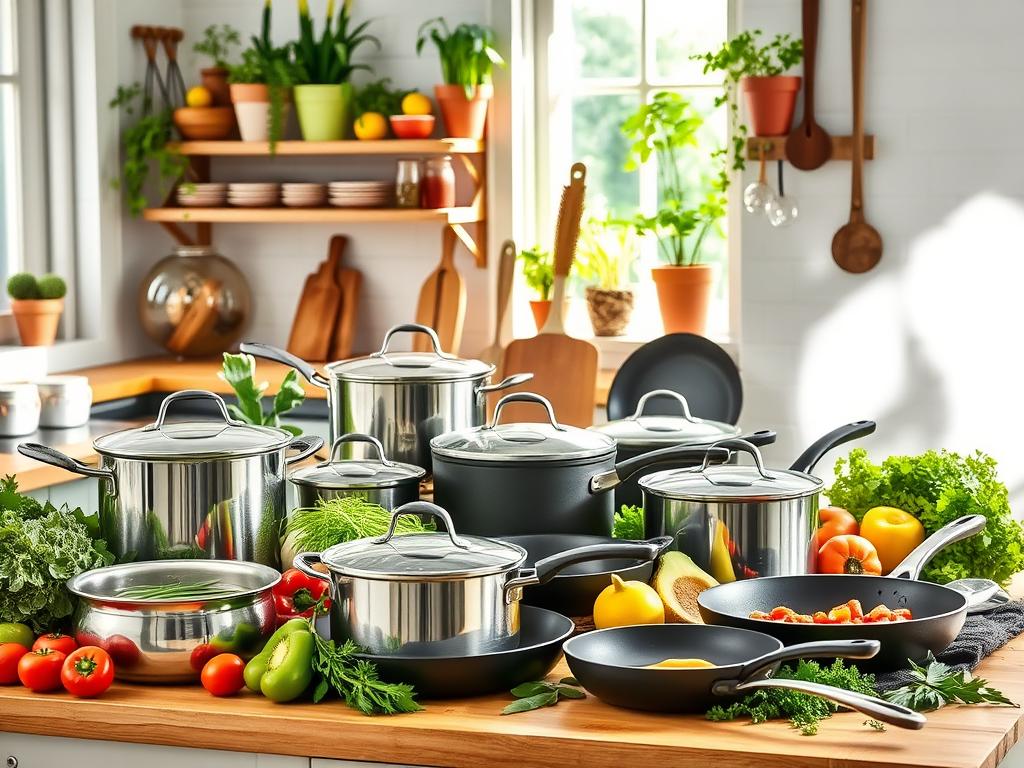Have you ever stepped into your kitchen, ready to create a meal that would warm the hearts of your loved ones, only to feel overwhelmed by the cookware options available? Choosing the right pots and pans can feel like navigating a culinary maze, especially when you’re seeking the best cookware that truly suits your cooking style and budget. A cookware buying guide is invaluable as you strive to select pieces that won’t just survive, but thrive through endless family dinners and personal culinary adventures.
In this guide, we will explore how to choose cookware that fits your needs, highlights the importance of material quality, and empowers you to make educated decisions. Whether you’re contemplating stainless steel for its durability or thinking about a nostalgic cast iron skillet for that perfect sear, this guide will help alleviate the confusion. The right cookware isn’t just about aesthetics; it’s about the experiences and memories that will be made over home-cooked meals, like those mouthwatering baked BBQ chicken drumsticks that will have everyone coming back for seconds.
Key Takeaways
- Invest in high-quality cookware for durability and performance.
- Different materials serve different cooking techniques—know their benefits.
- Choose multi-purpose items like Dutch ovens and stockpots for varied meals.
- Consider heat source compatibility when selecting your cookware.
- Balance budget with quality to ensure long-term satisfaction.
- Proper care and maintenance will extend the life of your cookware.
Understanding Cookware Materials and Their Benefits
Choosing the right cookware can transform the way you prepare meals. Each material offers unique benefits that cater to different cooking styles and preferences. This cookware materials guide aims to inform readers about the best cookware materials available, helping you decide what fits your culinary needs.
Stainless Steel: Durability and Versatility
Stainless steel is renowned for its durability, resistance to rust, and versatility in cooking a variety of dishes. With a composition like “18/10” stainless steel, which includes chromium and nickel, this material provides excellent anti-corrosive properties. Its ability to withstand high temperatures makes it ideal for everything from frying to simmering sauces, making it a staple in many kitchens.
Non-Stick: Convenience and Easy Cleanup
Non-stick cookware, like those offered by Tefal, is favored for its convenience. Cooking delicate items such as eggs or pancakes becomes effortless, while cleanup is a breeze. This cookware style enhances the cooking experience by minimizing the need for excess oil or butter, ultimately promoting healthier meal preparation. The benefits of cookware materials like non-stick surfaces include reduced food sticking and faster cleaning times.
Cast Iron: Heat Retention and Flavor Enhancement
Cast iron cookware is known for its exceptional heat retention and the ability to enhance flavors. Over time, seasoned cast iron develops a natural non-stick surface, which improves with use. This material is perfect for slow cooking and braising, delivering delicious results. Additionally, its durability means it can last for generations, making it a worthwhile investment.
Copper: Optimal Heat Conductivity
Copper cookware is prized for its outstanding heat conductivity. With a thickness ranging from 1/16 to 1/8 inch, copper pans heat up and cool down quickly, allowing for precise cooking control. While typically more expensive, the benefits of copper include excellent responsiveness, integrity in flavors, and durability that can justify the investment for serious home cooks.

For further insights into selecting the best cookware materials tailored to personal cooking styles, explore this cookware materials guide. Whether you prefer the ease of non-stick or the durability of stainless steel, understanding each type enhances your cooking journey.
| Cookware Material | Benefits | Ideal Use Cases |
|---|---|---|
| Stainless Steel | Durable, anti-corrosive, versatile | Searing, sautéing, and boiling |
| Non-Stick | Easy cleanup, reduced sticking | Cooking eggs, pancakes, and delicate items |
| Cast Iron | Excellent heat retention, enhances flavors | Slow cooking, baking, and frying |
| Copper | Optimal heat conductivity, precise control | Sauces, delicate dishes, and position-sensitive cooking |
Consider these cookware materials to maximize the benefits of cookware materials available in your kitchen.
Essential Cookware Types for Every Kitchen
Every kitchen benefits from having a collection of essential cookware that caters to various cooking needs. Below are some of the best cookware types along with practical recommendations that meet the requirements of both novice and seasoned home chefs. Investing in a quality cookware set enhances the efficiency of meal preparation, making cooking a delightful experience.
Skillets and Fry Pans: Everyday Versatility
Skillets and fry pans provide exceptional versatility, suitable for countless cooking methods such as sautéing, frying, and searing. Stainless steel, non-stick, and cast iron are the three primary materials available.
- Made In Cookware 10-Inch Stainless Clad Frying Pan is a durable option that holds up well for everyday cooking tasks.
- The Lodge Pre-Seasoned Cast Iron Skillet stands out due to its affordability and long-lasting performance.
Saucepans: Perfect for Sauces and Boiling
When it comes to crafting sauces or boiling water, nothing equals a dependable saucepan. Choosing a model with even heat distribution enhances cooking outcomes.
- The Tramontina Covered Sauce Pan with Helper Handle ensures even cooking, making sauce preparation effortless.
- For nonstick options, the Made In Cookware NonStick Saucepan offers easy maintenance without sacrificing quality.
Dutch Ovens: Ideal for Slow Cooking and Baking
A Dutch oven excels in slow cooking as well as baking, making it a versatile kitchen staple. It is perfect for stews or casseroles that require extended cooking times.
- The STAUB Cast Iron Dutch Oven 5.5-Quart Round Cocotte is highly recommended for its durability and practical design.
Stockpots: For Big Batches and Soups
Stockpots are essential for preparing large quantities, whether it be hearty soups or stocks. A recommended size is one that can fit three chicken carcasses for making stock efficiently.
- An 8-quart stock pot, noted for its versatility, is ideal for both stocks and seafood dishes.

These categories highlight essential cookware for home chefs looking to refine their culinary skills. For more detailed guidelines and cookware set recommendations based on your specific needs, explore expert resources.
Factors to Consider When Selecting Cookware
Choosing the right cookware involves a careful consideration of various factors, particularly as different cooking techniques and preferences dictate specific needs. Understanding how to choose cookware effectively can lead to improved cooking experiences and results. Here are some critical factors to ponder when shopping for your cookware collection:
Heat Source Compatibility: Gas vs. Induction
When selecting cookware, heat source compatibility plays a vital role. If you use a gas stove, virtually any material will suffice. For induction stovetops, however, ensure your cookware is magnetic-friendly. Many budget cookware options may not be suitable for induction, which could lead to frustration in the kitchen.
Oven Safety: Cookware That Resists Temperature Changes
Not all cookware can withstand the heat of an oven. Check the manufacturer’s guidelines for oven safety to ensure your selected pieces won’t warp or degrade at high temperatures. Materials such as stainless steel and cast iron typically offer better resistance to temperature fluctuations.
Maintenance and Care: Long-Term Considerations
Caring for your cookware properly can significantly affect its lifespan. Each material requires different maintenance techniques. For example, although stainless steel is relatively low-maintenance, other materials like cast iron need regular seasoning to maintain their nonstick properties. Regularly following cookware buying tips can help ensure you keep your kitchn essentials in optimal condition.
Budget: Finding Quality Within Your Price Range
Setting a budget before you shop can help you focus on the cookware that best meets your needs without overspending. There are excellent budget cookware options available that balance cost and quality. Investing in a set rather than individual pieces often provides better value, especially when it includes varied sizes and shapes necessary for diverse cooking methods. Many high-quality sets offer a lifetime warranty, providing assurance against defects.
| Material | Compatibility | Oven Safety | Maintenance | Typical Cost |
|---|---|---|---|---|
| Stainless Steel | Gas, Electric, Induction | Yes, high temperatures | Low, hand wash recommended | $$ |
| Cast Iron | Gas, Electric | Yes, very high temperatures | Moderate, seasoning required | $$ |
| Non-Stick | Gas, Electric | Depends on brand | Low, careful cleaning required | $ |
| Copper | Gas, Electric | Yes, moderate temperatures | High, requires polishing | $$$ |
Popular Cookware Brands to Explore
When it comes to selecting the right cookware, many home cooks rely on well-known brands that consistently deliver quality and performance. Exploring some of the best cookware brands allows consumers to make informed choices based on their cooking needs and style.
All-Clad: Professional Quality for Home Cooks
All-Clad stands out as a top-rated cookware brand known for its durability and professional-grade materials. The aluminum core offers excellent heat distribution, enabling chefs to cook evenly. Although All-Clad products are considered expensive, they come with a lifetime warranty, indicating commitment to quality.
Tefal: Innovative Non-Stick Solutions
Tefal offers innovative non-stick cookware designed for easy cooking and cleanup. With their advanced coatings, users experience exceptional food release without compromising on health standards. Customers often mention the satisfaction of using Tefal’s products in cookware reviews, praising both the convenience and reliability.
Le Creuset: Timeless Cast Iron Craftsmanship
Le Creuset’s vibrant enamel cast iron cookware has garnered a devoted following among home cooks and professionals alike. Each piece is individually cast, guaranteeing longevity and performance. While considered a bit pricey, Le Creuset’s timeless designs and unmatched durability make it a worthwhile investment for serious cooks.
Calphalon: A Balance of Performance and Design
Calphalon strikes a perfect balance between aesthetics and functionality. Known for its thicker materials, this brand offers warp-resistant cookware that can withstand high heat. With comfortable handles and innovative design, Calphalon proves to be among the best cookware brands for home kitchns.

Tips for Maintaining and Caring for Your Cookware
Ensuring the longevity of your cookware involves effective care techniques tailored to the specific materials you choose. For instance, to preserve stainless steel’s shine and performance, use a gentle dish soap and soft sponge. Non-stick skillets require special attention; avoid metal utensils which can scratch the delicate coating. Regularly cleaning your cast iron with a brush and minimal soapy water will keep it seasoned and ready for use. These cookware care tips are vital for maintaining the visual appeal and functionality of your kitchen tools.
Cleaning Techniques: Preserve Your Cookware’s Lifespan
Each type of cookware necessitates unique cleaning methods. Incorporating non-toxic cleaners for ceramic and enamel-coated cast iron will help maintain their properties. Furthermore, always check the manufacturer’s instructions for specific cleaning recommendations to avoid harming your cookware. By prioritizing proper techniques, you can not only enhance the lifespan of your pots and pans but also ensure they remain safe for preparing your favorite meals.
Storage Solutions: Organizing Your Kitchen Efficiently
Efficient storage is key to maintaining the quality of your cookware. Stack pots and pans using soft liners to prevent scratches, and for smaller items, consider using vertical space by hanging them on hooks. Investing in drawer dividers can also help keep utensils organized. A well-organized kitchn not only enhances aesthetics but is also essential in conserving your cookware’s condition, thus promoting its longevity.
Avoiding Scratches and Damage: Best Practices
To avoid damage, be mindful of the utensils used on your cookware. Opt for silicone or wooden tools instead of metal, especially with non-stick surfaces. Additionally, always let your cookware cool down before washing to prevent warping from sudden temperature changes. By following these best practices, you contribute to the durability of your kitchn essentials.
Replacing Cookware: Knowing When to Upgrade
Over time, even the best cookware requires replacement. Watch for signs such as significant scratches in non-stick pans, rust on stainless steel, or a worn-out surface on cast iron. Understanding when to upgrade is crucial in maintaining a safe and efficient cooking environment. For more comprehensive guidance on lifestyle changes, consider checking out this step-by-step guide.











